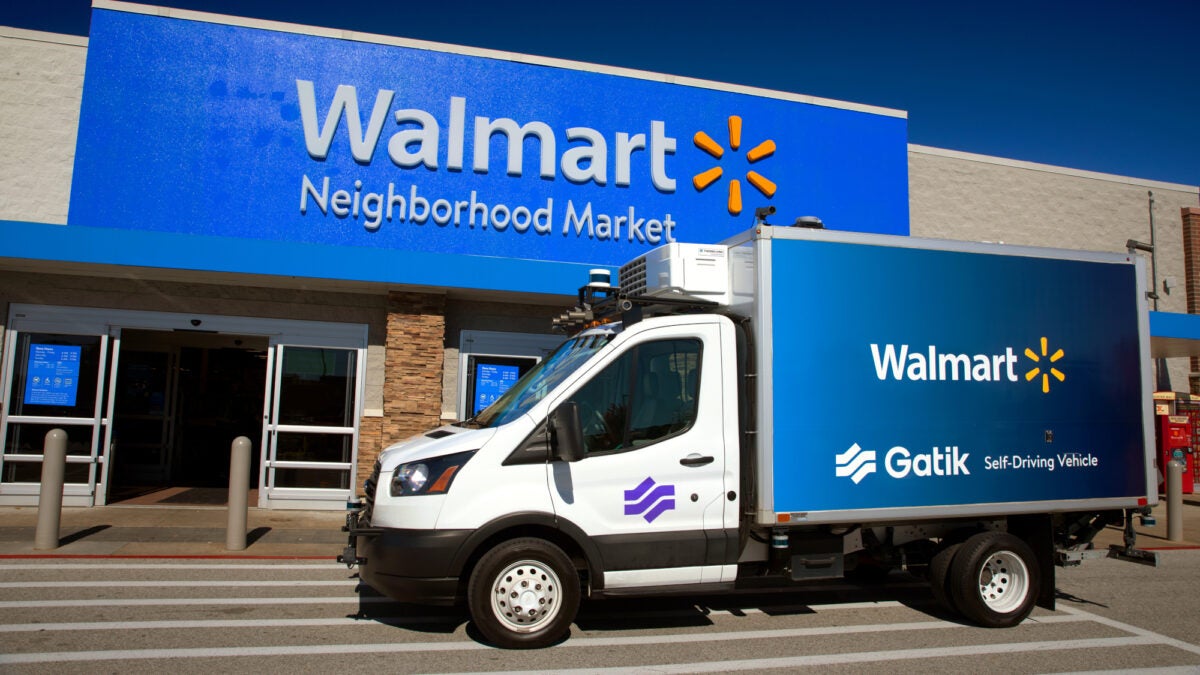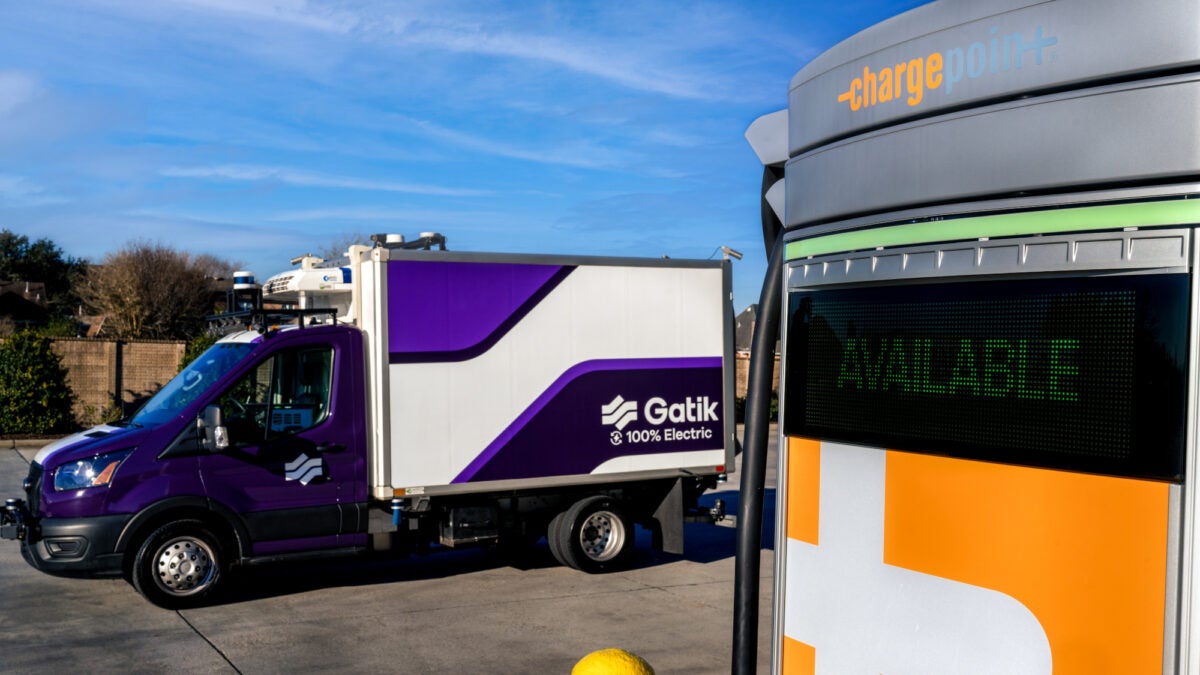Autonomous trucks continue to be “three to four years” away, but in Northwest Arkansas, they are the here and now.
Gatik, the autonomous vehicle technology company, has been running box trucks without a human in the driver’s seat since August in a pilot run in cooperation with Walmart. On Tuesday, Gatik co-founder and CEO Gautam Narang touted the accomplishments of the firm so far to an engaged audience at FreightWaves’ Future of Supply Chain conference at the Rogers Convention Center in Rogers, Arkansas.
“In 2017, when we started the company, we had two things in mind,” Narang told the audience. “The first one was [to] focus on the application that was more near term, and then at the same time, let’s solve a customer pain point.
“In 2016, most of the industry players were focusing on passenger transportation. Everyone was promising by 2020, 2021 we would have tens of thousands of robotaxis on the roads. Everyone was promising the problem would be solved. Everyone was saying 2021 is the year. Today, standing here in 2022, somehow the promises are being made for 2024 and 2025. We are always three to four years out.”

Solving for the middle mile
Gatik set out to address an often unseen but critically important segment of the supply chain — the middle mile. It is the movement of goods from distribution center to distribution center or retail location that enables the last mile to be successful. In Gatik’s case, the company is working several pilots, including the one with Walmart and another in Louisiana. Other pilots are being developed.
“Since August of last year, we have been working with our partner Walmart (NYSE: WMT) here in Arkansas without anyone behind the steering wheel,” Narang said. “For us, we have delivered on the promise of autonomy. And this year and next, we plan to scale that across multiple sites, multiple customers.”
The Arkansas pilot with Walmart sees the Gatik vehicle navigate a 7.1-mile route from a Walmart dark store (a store that stocks items for fulfillment but isn’t open to the public) to a Walmart neighborhood market in Bentonville.
Related:
Read: 2021 set the stage for ‘supersonic’ growth for Gatik
Read: Gatik fully removes the driver from its autonomous trucks
Additional pilots are being developed, including a current one with Loblaw Cos. (TSX: L.TO) in Ontario, Canada, and a recent collaboration with a major distributor. Details, including the distributor, of that pilot have yet to be made public, but Narang is looking forward to seeing his vehicles’ performance.
“We are very excited about that partnership because we get to replace a route that was initially served by a Class 8 truck by of our Class 6 26-footers,” he said. “This is a trend we are seeing across the industry; wherever possible, shippers are looking to move away from Class 8s because there is a shortage of license holders and wherever possible, they want to use our Class 6 box trucks.”

Electric charging partnership
Gatik recently announced a partnership with electric vehicle charging provider ChargePoint Holdings (NYSE: CHPT) to develop a charging ecosystem for Gatik customers throughout North America. ChargePoint will provide infrastructure and consultant services, including site design and interoperability validation, to Gatik customers looking to adopt the company’s Class 3-6 electric and autonomous middle-mile vehicles.
In October, Gatik announced a relationship with Ryder (NYSE: R) to provide vehicle lease and maintenance services. Gatik will outfit the vehicles with its self-driving technology that is the backbone of its autonomous delivery as a service (ADaaS) model. Ryder will maintain the vehicles, including calibration of its autonomous vehicle sensors and necessary pretrip and post-trip inspections.
In August, Gatik joined the AllianceTexas Mobility Innovation Zone. That program leverages a purpose-built industrial development in North Texas as a hub of supply chain innovation. The development plays host to a number of companies, including autonomous vehicle developer TuSimple, drone companies and railroads. All the companies participating in the program are involved in moving live freight.
Narang said autonomous vehicles are often grouped into three main segments. There are the over-the-road pilots, the middle mile and the final mile.
“One is the long haul, which is mostly focused on Class 8, mostly interstate, driving only on highways,” he said. “If you look at most of the players focused on Class 8, they have to disengage their system as soon as they leave the highway. On the other end of the spectrum, you have these slower and smaller robots making deliveries to the customer doorstep. The challenge … is you have to solve for delivery for every possible combination to the customer’s doorstep.”
Repeatable routes
Gatik is tackling that middle portion, moving items from a distribution center to a distribution center or a store. They are repeatable, fixed routes that allow the technology to become familiar with its environment.
“Why does it matter? Why do we believe this is going to be the critical segment of the supply chain?” he asked. “We really look at this, as everything is driven by end consumer expectations, and end consumers want their deliveries in the next one hour, the next two hours, or in the very latest the next day, and that is forcing the whole supply chain to move closer to the customer. And that is not just in the grocery space, not just in retail, it is happening across the supply chain, in distribution, CPG and e-commerce as well.”
Like the new pilot with the distributor, Narang sees middle-mile autonomous box trucks — which do not require CDLs — replacing some percentage of regional routes.
“That traditional route that was initially served by a Class 8 doing one or two routes a week has now been transformed into multiple deliveries every day and making more frequent deliveries,” Narang said. “And it does not make sense to operate a Class 8 semi-truck to make these deliveries. Now this single route has now transformed into multiple routes, and there is a need for more drivers, more trucks and more trips. Given the driver shortage today — it is so hard to find drivers — automation is the answer.
“This is what we see as the future of delivery, the future of the supply chain,” he concluded.
Click for more articles by Brian Straight.
You may also like:
Drones are flying into weather data deserts. Can they be stopped?
Navigating COVID-19 shipping chaos: Finding capacity and servicing the customer







